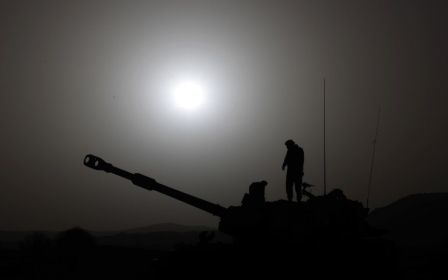Netanyahu: Iran building missile production sites in Syria, Lebanon
Prime Minister Benjamin Netanyahu said on Monday that Iran is building sites to produce precision-guided missiles in Syria and Lebanon, with the aim of using them against Israel.
At the start of a meeting in Jerusalem with UN Secretary-General Antonio Guterres, Netanyahu accused Iran of turning Syria into a "base of military entrenchment as part of its declared goal to eradicate Israel."
"It is also building sites to produce precision-guided missiles towards that end, in both Syria and in Lebanon. This is something Israel cannot accept. This is something the UN should not accept," Netanyahu said.
Iran, Israel's arch-enemy, has been Syrian President Bashar al-Assad's staunchest backer and has provided militia fighters to help him in Syria's civil war.
There was no immediate comment from Iran.
Israel has pointed to Tehran's steadily increasing influence in the region during the six-year-old Syrian conflict, whether via its own Revolutionary Guard forces or Shia Muslim proxies, especially Hezbollah.
On Wednesday, Netanyahu, in a meeting with Russian President Vladimir Putin, said Israel was prepared to act unilaterally to prevent an expanded Iranian military presence in Syria.
Russia, also an Assad ally, is seen as holding the balance of power in achieving a deal on Syria's future. Israel fears an eventual Assad victory could leave Iran with a permanent garrison in Syria, extending a threat posed from neighbouring Lebanon by Hezbollah.
Netanyahu accused Iran of building the production sites two weeks after an Israeli television report showed satellite images it said were of a facility Tehran was constructing in northwest Syria to manufacture long-range rockets.
The Channel 2 News report said the images were of a site near the Mediterranean coastal town of Baniyas and were taken by an Israeli satellite.
In parallel to lobbying Moscow, Israel has been trying to persuade Washington that Iran and its guerrilla partners, not Islamic State, pose the greater common threat in the region.
Middle East Eye propose une couverture et une analyse indépendantes et incomparables du Moyen-Orient, de l’Afrique du Nord et d’autres régions du monde. Pour en savoir plus sur la reprise de ce contenu et les frais qui s’appliquent, veuillez remplir ce formulaire [en anglais]. Pour en savoir plus sur MEE, cliquez ici [en anglais].




